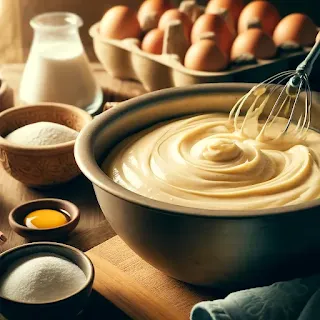Origin Story: Pound Cake
Pound cake is a classic dessert with a rich history that dates back several centuries. Known for its dense texture and buttery flavor, pound cake is a versatile treat that can be enjoyed on its own or with various toppings and accompaniments.
Historical Roots
The name "pound cake" comes from the traditional recipe, which originally called for a pound each of flour, butter, sugar, and eggs. This method of using equal weights of these four ingredients was first documented in Europe in the early 18th century. The simplicity of the recipe made it easy to remember and replicate, contributing to its widespread popularity.
The earliest known recipes for pound cake appear in English cookbooks from the early 1700s. Over time, the recipe spread to America, where it became a staple in Southern baking. American variations often included flavorings such as vanilla, lemon, or nutmeg, and sometimes the addition of leavening agents like baking powder to lighten the texture.
Cultural Significance
Pound cake holds a special place in both European and American culinary traditions. In Europe, it is often enjoyed during tea time or as a simple dessert. In the United States, particularly in the South, pound cake is a beloved dessert for family gatherings, holidays, and special occasions. Its rich, buttery flavor and dense, moist texture make it a comforting and satisfying treat.
The versatility of pound cake also contributes to its enduring popularity. It can be served plain, dusted with powdered sugar, glazed, or topped with fresh fruit, whipped cream, or ice cream. This adaptability allows it to fit into a wide range of culinary traditions and personal preferences.
Personal Connection
My love for pound cake began in my grandmother's kitchen, where she would bake it for family gatherings. The process of making pound cake was a ritual that I cherished, from creaming the butter and sugar to watching the cake rise slowly in the oven. The aroma that filled the house as the cake baked was irresistible, and the first slice, warm from the oven, was always a special treat.
My grandmother’s pound cake was simple, with a hint of vanilla and a perfect crumb. Over the years, I’ve experimented with her recipe, adding different flavors and ingredients to create my own variations. One of my favorites includes a touch of lemon zest and a lemon glaze, which adds a refreshing tang to the rich, buttery cake.
Recipe Evolution
Creating the perfect pound cake involves a few key steps. The traditional method of using equal weights of flour, butter, sugar, and eggs ensures a rich and dense texture. However, modern recipes often adjust these proportions slightly to achieve a lighter cake. The key is to cream the butter and sugar until light and fluffy, which helps incorporate air into the batter and gives the cake a tender crumb.
Adding flavorings such as vanilla extract, almond extract, or citrus zest can enhance the basic recipe. Some variations include sour cream or buttermilk, which add moisture and a subtle tang. Baking the cake at a moderate temperature helps ensure it cooks evenly and develops a beautiful golden crust.
Sharing the Tradition
Today, pound cake remains a favorite in my home and is often the dessert I bake for special occasions or when I want to share a comforting treat with friends and family. Each slice is a reminder of my grandmother’s kitchen and the joy of baking something simple yet delicious.
Ingredients:
Instructions:
🍥Preparation:
- Preheat your oven to 350°F (175°C). Grease and flour a 9x5 inch loaf pan, or line it with parchment paper for easy removal.
- In a large bowl, using an electric mixer, cream together the softened butter and sugar until light and fluffy, about 3-4 minutes.
- Add the eggs one at a time, beating well after each addition, then mix in the vanilla extract.
🍥Mixing & Baking:
- Sift together the flour and salt. Gradually add the dry ingredients to the wet ingredients, mixing on low speed just until combined.
- Pour the batter into the prepared loaf pan, smoothing the top with a spatula.
- Bake in the preheated oven for 50-60 minutes, or until a toothpick inserted into the center comes out clean.
- Allow the cake to cool in the pan for 10 minutes before transferring it to a wire rack to cool completely.
Pro Tips:
- Make sure all ingredients are at room temperature to ensure they blend smoothly and evenly.
- To prevent overbaking, start checking the cake at the 50-minute mark.



No comments:
Post a Comment